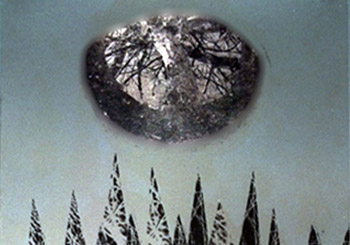PROJECTS
Lords of themselves

1994
RCA Installation
What does it mean to be a lord? Does it simply imply that one is better than other human beings and therefore entitled to exercise power over them, as the common use of the word suggests? Or are there other sorts of lordship, too? The visual inspiration for this installation has been the form of the dove as a symbol of the pure aspect of the human spirit that brings freedom and inner peace. In Christian iconography it stands also for the Holy Spirit, the force that inspires the motion of all entities in the universe. Being faithful to our true spirit is what makes us, after all, lords of ourselves, able to stand proud in a community of equals and stay in connection to our origins and our inmost nature – much like the loft of pigeons presented here, emerging from the foliage of an imaginary garden.
Magritte in the Garden

1991 - 1992
Magritte’s simple compositions that focus persistently on specific objects or scenes, thus endowing them with an uncanny, dreamlike quality, have largely inspired the structure of this group of works. The simple shapes and themes, however, have been invested with an extra layer of herbal patterns – close-up snapshots of moments in a garden, one could say. Gardens have often represented the holy place where matter meets spirit in many an iconographic tradition (in Europe, Byzantium, Islam, Japan et al.). To cultivate a garden, one needs to accept and respectfully pay heed to the natural patterns of change within it. The same goes for the cultivation of the human heart, where art may be present both as a necessary utensil and as a brilliant flower.
Early works

1990 - 1991
In this group of early works, the media used (mostly woodcut and etching) were not chosen so much for their potential to produce multiple copies but more for their particular mode of expression: the deep contrasts and the sharp incisions employed in engraving are the perfect means to illustrate the profound contradictions and paradoxes that make up human existence itself. The fixedness of the compositions is a historical reference to the symbolic landscapes used as backdrops for the holy scenes in Byzantine and medieval iconography.


































